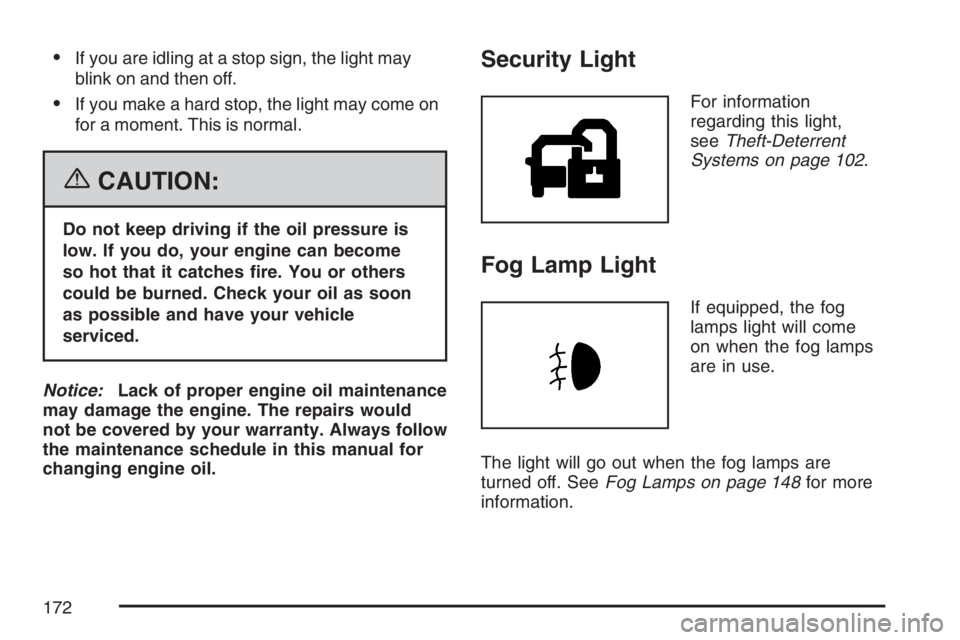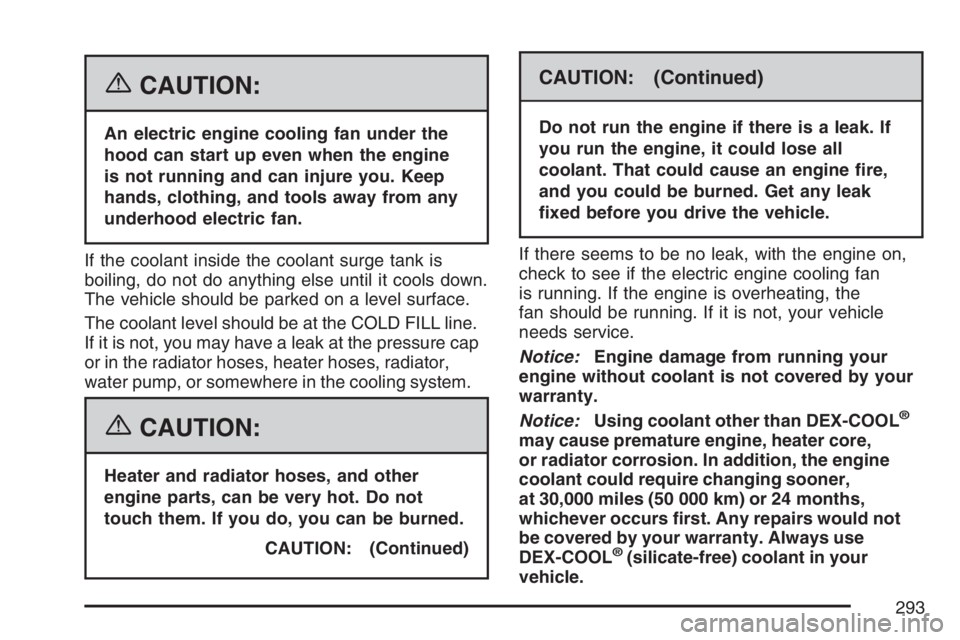2007 PONTIAC G5 oil pressure
[x] Cancel search: oil pressurePage 93 of 428

The remote vehicle start feature will not operate if
any of the follow occur:
The remote start system is disabled through
the DIC.
The vehicle’s key is in the ignition.
The vehicle’s hood is open.
The hazard warning �ashers are on.
The check engine light is on. SeeMalfunction
Indicator Lamp on page 168.
The engine coolant temperature is too high.
The oil pressure is low.
Two remote vehicle starts have already been
provided for that ignition cycle.
Vehicles that have the remote vehicle start feature
are shipped from the factory with the remote
start system enabled. The system may be enabled
or disabled through the DIC. See “REMOTE
START” underDIC Vehicle Personalization on
page 179for additional information.
Remote Start Ready
(Automatic Transaxle Only)
If your vehicle does not have the remote vehicle
start feature, it may have the remote start
ready feature. This feature allows your dealer to
add the manufacturer’s remote vehicle start
feature.
If the RKE transmitter has a plus (+) symbol on
the back cover, your vehicle has the remote start
ready feature. You can lock or unlock your
vehicle from about 197 feet (60 m) away.
See your dealer if you would like to add the
manufacturer’s remote vehicle start feature to your
vehicle.
93
Page 134 of 428

Anti-Lock Brake System Warning Light...... 166
Enhanced Traction System
Warning Light........................................ 166
Engine Coolant Temperature
Warning Light........................................ 167
Malfunction Indicator Lamp........................ 168
Oil Pressure Light..................................... 171
Security Light............................................ 172
Fog Lamp Light......................................... 172
Highbeam On Light................................... 173
Fuel Gage................................................. 173
Driver Information Center (DIC).................. 174
DIC Operation and Displays...................... 174
DIC Warnings and Messages.................... 177
DIC Vehicle Personalization....................... 179Audio System(s)......................................... 185
Setting the Time
(Without Date Display)........................... 186
Setting the Time (With Date Display)......... 187
Radio with CD (Base)............................... 189
Radio with CD (MP3)................................ 194
Using an MP3........................................... 205
XM Radio Messages................................. 212
Theft-Deterrent Feature............................. 214
Audio Steering Wheel Controls.................. 214
Radio Reception........................................ 215
Care of Your CDs..................................... 216
Care of the CD Player.............................. 216
Fixed Mast Antenna.................................. 216
XM™ Satellite Radio Antenna System....... 216
Section 3 Instrument Panel
134
Page 171 of 428

Emissions Inspection and Maintenance
Programs
Some state/provincial and local governments have
or may begin programs to inspect the emission
control equipment on your vehicle. Failure to pass
this inspection could prevent you from getting a
vehicle registration.
Here are some things you need to know to help
your vehicle pass an inspection:
Your vehicle will not pass this inspection if the
check engine light is on or not working properly.
Your vehicle will not pass this inspection if the OBD
(on-board diagnostic) system determines that
critical emission control systems have not been
completely diagnosed by the system. The vehicle
would be considered not ready for inspection.
This can happen if you have recently replaced
your battery or if your battery has run down. The
diagnostic system is designed to evaluate critical
emission control systems during normal driving.
This may take several days of routine driving. If you
have done this and your vehicle still does not pass
the inspection for lack of OBD system readiness,
your dealer can prepare the vehicle for inspection.
Oil Pressure Light
If you have a low engine
oil pressure problem,
this light will stay on after
you start your engine, or
come on when you are
driving.
This indicates that your engine is not receiving
enough oil.
The engine could be low on oil, or could have
some other oil problem. Have it �xed immediately.
The oil light could also come on in three other
situations:
When the ignition is on but the engine is not
running, the light will come on as a test to show
you it is working, but the light will go out when
you turn the ignition to START. If it does not
come on with the ignition on, you may have a
problem with the fuse or bulb. Have it �xed
right away.
171
Page 172 of 428

If you are idling at a stop sign, the light may
blink on and then off.
If you make a hard stop, the light may come on
for a moment. This is normal.
{CAUTION:
Do not keep driving if the oil pressure is
low. If you do, your engine can become
so hot that it catches �re. You or others
could be burned. Check your oil as soon
as possible and have your vehicle
serviced.
Notice:Lack of proper engine oil maintenance
may damage the engine. The repairs would
not be covered by your warranty. Always follow
the maintenance schedule in this manual for
changing engine oil.
Security Light
For information
regarding this light,
seeTheft-Deterrent
Systems on page 102.
Fog Lamp Light
If equipped, the fog
lamps light will come
on when the fog lamps
are in use.
The light will go out when the fog lamps are
turned off. SeeFog Lamps on page 148for more
information.
172
Page 240 of 428

Once you are moving on the freeway, make
certain you allow a reasonable following distance.
Expect to move slightly slower at night.
When you want to leave the freeway, move to the
proper lane well in advance. If you miss your
exit, do not, under any circumstances, stop and
back up. Drive on to the next exit.
The exit ramp can be curved, sometimes quite
sharply. The exit speed is usually posted. Reduce
your speed according to your speedometer, not
to your sense of motion. After driving for any
distance at higher speeds, you may tend to think
you are going slower than you actually are.
Before Leaving on a Long Trip
Make sure you are ready. Try to be well rested.
If you must start when you are not fresh — such as
after a day’s work — do not plan to make too
many miles that �rst part of the journey. Wear
comfortable clothing and shoes you can easily
drive in.
Is your vehicle ready for a long trip? If you keep it
serviced and maintained, it is ready to go. If it
needs service, have it done before starting out.Of course, you will �nd experienced and able
service experts in GM dealerships all across
North America. They will be ready and willing to
help if you need it.
Here are some things you can check before a trip:
Windshield Washer Fluid:Is the reservoir
full? Are all windows clean inside and outside?
Wiper Blades:Are they in good shape?
Fuel, Engine Oil, Other Fluids:Have you
checked all levels?
Lamps:Are they all working? Are the lenses
clean?
Tires:They are vitally important to a safe,
trouble-free trip. Is the tread good enough
for long-distance driving? Are the tires
all in�ated to the recommended pressure?
Weather Forecasts:What is the weather
outlook along your route? Should you
delay your trip a short time to avoid a major
storm system?
Maps:Do you have up-to-date maps?
240
Page 265 of 428

Service........................................................ 268
Accessories and Modi�cations................... 268
California Proposition 65 Warning.............. 269
Doing Your Own Service Work.................. 269
Adding Equipment to the Outside of
Your Vehicle.......................................... 270
Fuel............................................................. 270
Gasoline Octane........................................ 270
Gasoline Speci�cations.............................. 271
California Fuel........................................... 271
Additives................................................... 272
Fuels in Foreign Countries........................ 273
Filling the Tank......................................... 274
Filling a Portable Fuel Container............... 276
Checking Things Under the Hood.............. 276
Hood Release........................................... 277
Engine Compartment Overview.................. 278
Engine Oil................................................. 279
Engine Oil Life System.............................. 282
Engine Air Cleaner/Filter............................ 284
Automatic Transaxle Fluid......................... 286
Manual Transaxle Fluid............................. 286
Hydraulic Clutch........................................ 286Engine Coolant.......................................... 287
Coolant Surge Tank Pressure Cap............ 290
Engine Overheating................................... 290
Cooling System......................................... 292
Windshield Washer Fluid........................... 297
Brakes...................................................... 298
Battery...................................................... 303
Jump Starting............................................ 304
Headlamp Aiming........................................ 309
Bulb Replacement....................................... 312
Halogen Bulbs........................................... 312
Headlamps, Front Turn Signal,
Sidemarker, and Parking Lamps............. 313
Center High-Mounted Stoplamp
(CHMSL)................................................ 315
Taillamps and Turn Signal Lamps
(Coupe)................................................. 316
Taillamps, Turn Signal, Stoplamps and
Back-up Lamps (Sedan)......................... 316
Back-Up Lamps (Coupe)........................... 317
License Plate Lamp................................... 318
Replacement Bulbs................................... 318
Section 5 Service and Appearance Care
265
Page 293 of 428

{CAUTION:
An electric engine cooling fan under the
hood can start up even when the engine
is not running and can injure you. Keep
hands, clothing, and tools away from any
underhood electric fan.
If the coolant inside the coolant surge tank is
boiling, do not do anything else until it cools down.
The vehicle should be parked on a level surface.
The coolant level should be at the COLD FILL line.
If it is not, you may have a leak at the pressure cap
or in the radiator hoses, heater hoses, radiator,
water pump, or somewhere in the cooling system.
{CAUTION:
Heater and radiator hoses, and other
engine parts, can be very hot. Do not
touch them. If you do, you can be burned.
CAUTION: (Continued)
CAUTION: (Continued)
Do not run the engine if there is a leak. If
you run the engine, it could lose all
coolant. That could cause an engine �re,
and you could be burned. Get any leak
�xed before you drive the vehicle.
If there seems to be no leak, with the engine on,
check to see if the electric engine cooling fan
is running. If the engine is overheating, the
fan should be running. If it is not, your vehicle
needs service.
Notice:Engine damage from running your
engine without coolant is not covered by your
warranty.
Notice:Using coolant other than DEX-COOL
®
may cause premature engine, heater core,
or radiator corrosion. In addition, the engine
coolant could require changing sooner,
at 30,000 miles (50 000 km) or 24 months,
whichever occurs �rst. Any repairs would not
be covered by your warranty. Always use
DEX-COOL
®(silicate-free) coolant in your
vehicle.
293
Page 295 of 428

{CAUTION:
Adding only plain water to your cooling
system can be dangerous. Plain water, or
some other liquid such as alcohol, can
boil before the proper coolant mixture will.
Your vehicle’s coolant warning system is
set for the proper coolant mixture. With
plain water or the wrong mixture, your
engine could get too hot but you would
not get the overheat warning. Your engine
could catch �re and you or others could
be burned. Use a 50/50 mixture of clean,
drinkable water and DEX-COOL
®coolant.
Notice:In cold weather, water can freeze and
crack the engine, radiator, heater core and
other parts. Use the recommended coolant
and the proper coolant mixture.
{CAUTION:
You can be burned if you spill coolant on
hot engine parts. Coolant contains
ethylene glycol and it will burn if the engine
parts are hot enough. Do not spill coolant
on a hot engine.
1. You can remove the coolant surge tank
pressure cap when the cooling system,
including the coolant surge tank pressure
cap and upper radiator hose, is no longer hot.
Turn the pressure cap slowly counterclockwise
about two or two and one-half turns. If you hear
a hiss, wait for that to stop. This will let any
pressure still left to be vented out the
discharge hose.
295